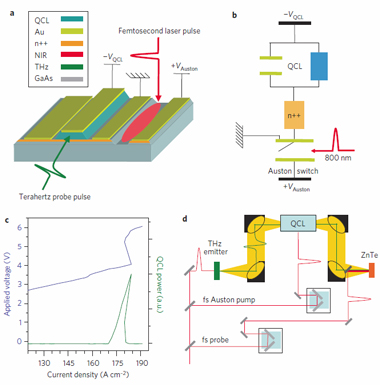
| Home | About Us | Contribute | Bookstore | Advertising | Subscribe for Free NOW! |
| News Archive | Features | Events | Recruitment | Directory |
| FREE subscription |
| Subscribe for free to receive each issue of Semiconductor Today magazine and weekly news brief. |
News
24 November 2009
Accessing higher THz gain with switched quantum cascade lasers
Researchers in France (École Normale Supérieure, Université Denis Diderot) and the UK (University of Leeds) have been seeking to improve amplification at terahertz frequencies (THz = 1012Hz) using a quantum cascade laser (QCL) [Nathan Jukam et al, Nature Photonics, online 22 November 2009].
The researchers’ main interest is in improving time-domain spectroscopy (TDS) in the THz region, where the amplification of amplitude and phase information in signals would increase the usefulness of the technique. However, such amplification is presently lacking in the THz ‘gap’ between electromagnetic waves in the radio/microwave region (roughly, less than 300GHz) and light (i.e. mid/near-infrared, visible, ultraviolet, x-ray, etc more than 3THz = 3000GHz).
TDS works by exciting a sample with a narrow pulse of radiation and then looking for the response. The technique has been used to create images, for non-destructive testing, and for detection of complex compounds (e.g. explosives).
Another recent application has been to study the gain spectra of QCLs. QCLs consist of thousands of layers of semiconductor material designed to create ‘sub-bands’ with extremely low frequency transitions in the far- and mid-infrared, even shading into the THz range.
This gain-probing application suggests that QCLs could be a useful medium for amplifying THz signals. A difficulty arises, however. The gain is limited when laser action begins by waveguide and mirror losses in QCL laser structures, an effect known as ‘gain clamping’. Reducing such losses by applying anti-reflective coatings is hard, since in the THz region such coatings have to be very thick. Another technique, where one tapers the laser structure, leads to astigmatism of the amplified signal. TDS needs high beam quality and a tight focus on the detector to maximize the measured signal. This precludes the use of tapered QCLs at present.
The French-UK team has used gain-switching to improve QCL-based THz amplification by up to 26 decibels (~400x), excluding coupling losses. This is achieved by limiting the time that the QCL is on. In the build-up period of the laser field, the gain is not clamped by the value during laser action, and the gain can then be greater than the clamped value.
The researchers used an ‘Auston switch’ to turn on a QCL, which is maintained at a voltage level just below threshold. An external femtosecond laser pulse (80fs duration with 820nm center wavelength) creates carriers in the Auston switch region, increasing its conductivity and thus pushing the voltage level of the QCL above threshold.

Figure 1: Experimental set-up for creating unclamped gain. (a) Schematic of QCL with Auston switch integrated into side contact. (b) Circuit schematic with QCL represented as a capacitor and a resistor in parallel. (c) Pulsed light–current (lower) and voltage–current (upper) curves of the 2.4THz QCL at 7K. (d) Experimental apparatus schematic.
The QCL was based on transitions from an isolated bound state in a mini-band gap to continuum states in the mini-band below. The active region of the QCL consisted of 90 periods of 18 alternating layers of gallium arsenide (GaAs) wells and aluminum gallium arsenide (Al0.15Ga0.85As) barriers of various thicknesses. The lasing frequency of the device was 2.4THz.
The adjacent Auston switch was created by etching through a gold-germanium-nickel (AuGeNi) contact layer to the semi-insulating GaAs substrate. Laser bars were created through cleavage to give 1.5mm-long devices. The measurements were made with the QCL assembly located in a helium flow cryostat that maintained a temperature of 7K.
The detector was based on a zinc telluride (ZnTe) crystal using electro-optic techniques where the polarization of a light pulse is shifted by the presence of THz radiation, allowing amplitude and phase information to be collected.
The femtosecond laser pulse used in the experiments to activate the Auston switch was also used to generate the THz radiation from a photoconductive antenna. Such antennas are deposited on GaAs substrates. The antenna responds to the laser radiation by creating a burst of photo-current between different parts of a biased antenna array. The burst creates the THz radiation. The femtosecond laser pulse repeated at a 76MHz frequency and had an average power of 360mW.
Measurements of transmitted THz pulses show that, with the Auston switch off, the signal decays as it passes back and forth through the QCL (Figure 2). By contrast, when the switch is on, the signal increases, demonstrating gain. The gain increases up to about 60ps, after which it begins to decline.

Figure 2: Fields and spectra of the terahertz probe pulses with the Auston switch ON and OFF with the THz signal having made up to seven passes through the QCL gain medium. The Auston switch is biased at 27.5V. The bias across the QCL when the switch is off is just below threshold (3-4V).
The researchers speculate that using the same switch-on technique with different sorts of QCL (e.g. longitudinal phonon-based devices) with better bare cavity gains could lead to even more amplification. Also, finding better ways to couple THz radiation into the QCL would also lead to improved performance. Current coupling efficiencies are about a few percent. Increasing the length of the cavity could also reduce losses from the QCL facets.
Increasing the duration of the photo-induced current in the Auston switch could also lead to amplification up to the saturation field value (~1kV/cm). This would be an injection-locking effect that could also create a high field source of narrow-band THz radiation pulses.
See related items:
Magnetic QCL emits 3THz at 225K and 0.68THz at 8K
First room-temperature semiconductor source of coherent terahertz radiation
Visit: http://dx.doi.org/10.1038/NPHOTON.2009.213
The author Mike Cooke is a freelance technology journalist who has worked in the semiconductor and advanced technology sectors since 1997.